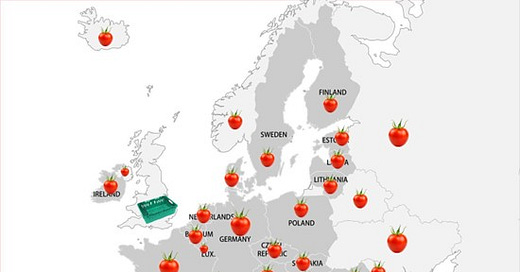The UK is currently in the throes of a tomato famine. There’s a widespread shortage of tomatoes, lettuce, and peppers, with some supermarket shelves empty and some of the country’s biggest retailers rationing their precious salad vegetables (or should it be fruits?).
According to the BBC, aka the UK government, the explanation for this is bad weather in Morocco and in the south of Spain – now the main suppliers to the UK in winter following Brexit. There are also clear links to the carbon cycle.
Most of the tomatoes grown in the UK are cultivated in vast greenhouses such as those in the Lea Valley to the east of London. The advantage of growing plants in these huge glasshouses is that you can control the internal environment: the temperature, the humidity, the amount of light. You also minimise the chances of parasites and hence the need for chemical intervention. In a hydroponic greenhouse far less fertiliser is used, and what is used is much more effective.
The greenhouses in the Lea Valley are heated with hot water pipes fed from large gas boilers adjacent to the glasshouses – a direct link to the carbon cycle. The atmosphere inside also has enhanced levels of CO2 (to aid photosynthesis), with that also coming from the flue of the boilers. Tomatoes thrive with high levels of CO2: the higher the levels in the glasshouse, the faster they grow. So, here is another clear link to the carbon cycle.
But it doesn’t end there, because the nitrogenous fertiliser which is dissolved and then piped into the soil substrate upon which the tomato vines grow is also a fossil fuel product. The vast majority of the world’s nitrate fertiliser is made via the Haber Bosch process, probably the single most important chemical process in the world. The process converts atmospheric nitrogen (N2) to ammonia (NH3) by a reaction with hydrogen (H2) using a metal catalyst under high temperatures and pressures, again a function of fossil fuel consumption.
Tomatoes, in other words, have a fossil fuel connection in three dimensions – direct heat, CO2 production and fertiliser. Energy costs are now the single biggest costs for a greenhouse grower, exacerbated by the spike in gas prices following the Russian invasion of Ukraine in 2022.
More than half the acreage in the glasshouses in the Lea Valley were left empty in 2022 - something totally unprecedented. Some growers gambled that they could afford the energy costs; others just gave up. The point here is that were it not for higher energy costs, the UK would have grown more of its own tomatoes and hence the country wouldn’t have been quite so exposed to the current shortfall in supply. The fact that there might not be enough pickers for the crop due to Brexit has also to be factored in.
Unfortunately, the rest of Europe is also importing more tomatoes too, and most of the nitrate fertiliser plants have closed. Most of the needed ammonia is imported from overseas. Some comes from the USA, where it is made with fracked shale gas (clearly not good for the global carbon cycle). Some comes from China, where coal is used as the initial source – an even worse outcome for the global carbon cycle!
So, when we finally get around to making ‘green’ fertiliser from renewable energy sources, it is fair to say we will need enormous amounts of energy for fertilisers, glasshouses and …. tomatoes.




